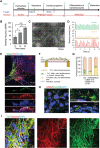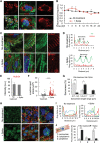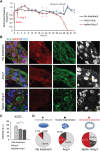Sars-Cov-2 Spike Protein-Induced Damage of hiPSC-Derived Cardiomyocytes
- PMID: 35523737
- PMCID: PMC9347759
- DOI: 10.1002/adbi.202101327
Sars-Cov-2 Spike Protein-Induced Damage of hiPSC-Derived Cardiomyocytes
Abstract
Sars-Cov-2 may trigger molecular and functional alterations of cardiomyocytes (CMs) of the heart due to the presence of receptor angiotensin-converting enzyme 2 (ACE2) of the host cells. While the endocytic itinerary of the virus via cleavage of the spike protein of Sars-Cov-2 is well understood, the role of the remaining part of the spike protein subunit and ACE2 complex is still elusive. Herein, the possible effects of this complex are investigated by using synthetic spike proteins of Sars-Cov-2, human-induced pluripotent stem cells (hiPSC), and a culture device made of an arrayed monolayer of cross-linked nanofibers. hiPSCs are first differentiated into CMs that form cardiac tissue-like constructs with regular beating and expression of both ACE2 and gap junction protein Connexin 43. When incubated with the spike proteins, the hiPSC-CMs undergo a rhythmic fluctuation with overstretched sarcomere structures and dispersed gap junction proteins. When incubated with the spike proteins and supplementary angiotensin II, the damage of the spike protein on hiPSC-CMs is enhanced due to downregulated ACE2, chromatin margination, altered Connexin 43 expression, sarcomere disruption, and beating break. This discovery may imply latent effects of the spike proteins on the heart.
Keywords: ACE2; Ang II; Sars-Cov-2; cardiomyocytes; hiPSC; spike protein.
© 2022 Wiley-VCH GmbH.
Conflict of interest statement
The authors declare no conflict of interest.
Figures






Similar articles
-
Highly Efficient SARS-CoV-2 Infection of Human Cardiomyocytes: Spike Protein-Mediated Cell Fusion and Its Inhibition.J Virol. 2021 Nov 23;95(24):e0136821. doi: 10.1128/JVI.01368-21. Epub 2021 Oct 6. J Virol. 2021. PMID: 34613786 Free PMC article.
-
Glycated ACE2 receptor in diabetes: open door for SARS-COV-2 entry in cardiomyocyte.Cardiovasc Diabetol. 2021 May 7;20(1):99. doi: 10.1186/s12933-021-01286-7. Cardiovasc Diabetol. 2021. PMID: 33962629 Free PMC article.
-
SARS-CoV-2 infects and induces cytotoxic effects in human cardiomyocytes.Cardiovasc Res. 2020 Dec 1;116(14):2207-2215. doi: 10.1093/cvr/cvaa267. Cardiovasc Res. 2020. PMID: 32966582 Free PMC article.
-
Risk impact of SARS-CoV-2 coronavirus and spike protein on cardiac tissue: a comprehensive review.Physiol Res. 2024 Dec 31;73(S3):S655-S669. doi: 10.33549/physiolres.935476. Physiol Res. 2024. PMID: 39808169 Free PMC article. Review.
-
Potential therapeutic approaches for the early entry of SARS-CoV-2 by interrupting the interaction between the spike protein on SARS-CoV-2 and angiotensin-converting enzyme 2 (ACE2).Biochem Pharmacol. 2021 Oct;192:114724. doi: 10.1016/j.bcp.2021.114724. Epub 2021 Aug 8. Biochem Pharmacol. 2021. PMID: 34371003 Free PMC article. Review.
Cited by
-
Cardiac Safety of mRNA-Based Vaccines in Patients with Systemic Lupus Erythematosus and Lupus-like Disorders with a History of Myocarditis.Pathogens. 2022 Sep 1;11(9):1001. doi: 10.3390/pathogens11091001. Pathogens. 2022. PMID: 36145434 Free PMC article.
-
Safety of COVID-19 Vaccines in Patients with Autoimmune Diseases, in Patients with Cardiac Issues, and in the Healthy Population.Pathogens. 2023 Feb 2;12(2):233. doi: 10.3390/pathogens12020233. Pathogens. 2023. PMID: 36839505 Free PMC article. Review.
-
Viral Infection and Connexin Dysfunction in the Heart.Curr Cardiol Rep. 2025 Mar 27;27(1):76. doi: 10.1007/s11886-025-02227-6. Curr Cardiol Rep. 2025. PMID: 40146392 Free PMC article. Review.
-
Spike Protein of SARS-CoV-2 Activates Cardiac Fibrogenesis through NLRP3 Inflammasomes and NF-κB Signaling.Cells. 2024 Aug 11;13(16):1331. doi: 10.3390/cells13161331. Cells. 2024. PMID: 39195221 Free PMC article.
-
Sympathetic remodeling and altered angiotensin-converting enzyme 2 localization occur in patients with cardiac disease but are not exacerbated by severe COVID-19.Auton Neurosci. 2024 Feb;251:103134. doi: 10.1016/j.autneu.2023.103134. Epub 2023 Dec 1. Auton Neurosci. 2024. PMID: 38101169 Free PMC article.
References
-
- Wiersinga W. J., Rhodes A., Cheng A. C., Peacock S. J., Prescott H. C., Pathophysiology, T. , JAMA 2020, 324, 782. - PubMed
Publication types
MeSH terms
Substances
LinkOut - more resources
Full Text Sources
Medical
Miscellaneous

